
Original Link: https://www.anandtech.com/show/2025
Computex 2006: Abit is back, Biostar expands, and Thermaltake dazzles
by Gary Key on June 10, 2006 4:00 AM EST- Posted in
- Trade Shows
We have recently returned from Computex 2006 with our heads still spinning after viewing literally thousands of products from a multitude of suppliers. We already provided some pre-show coverage, but there's still lots more to see and talk about. This year's show was a general success and while several companies were launching new products in different market segments, the talk of the town was Core 2 Duo (Conroe) and AMD's expected response. AMD's first response in the short term very well could be the purchase of ATI; whether this truly makes business sense for either party is up for debate considering ATI's close relationship with Intel and AMD's long term partnership with NVIDIA, but privately representatives from both Intel and NVIDIA told us they were already discussing the potential effects of this merger internally.
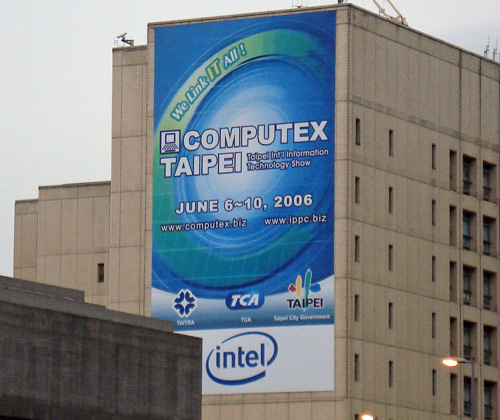
While the focus of the latest Computex was definitely on Core 2 Duo products, we did see a significant amount of AMD AM2 products with the low to ultra low end being dominated by VIA and SIS. However, we were told by several motherboard suppliers that NVIDIA plans on aggressively pursuing the upper low end range of the AM2 market with expected board prices for the micro-ATX GeForce 6100 boards reaching US $53 and nForce4 ATX boards reaching US $60 price points in the near future.
Several of the manufacturers told us that NVIDIA is offering incentives on the nForce4 Ultra chipsets in order to move out this inventory, and we noticed a significant amount of AM2 boards based on this chipset and very few on the nForce 550 at the low end of NVIDIA's AM2 product roadmap. While NVIDIA does not appear willing to go after (at this time) the under US $50 market, the fact that they will be creeping up on this price point is sure to place additional pricing pressures on VIA and SIS at the top of their product ranges.
ATI's market plans in the AM2 segment were a little less clear as very few suppliers were showing the Radeon Xpress 300 or 1100 micro-ATX boards, essentially a Radeon Xpress 200 Northbridge (X300 integrated graphics) with DDR2 support and either the SB460 Southbridge in the 300 or SB600 Southbridge in the 1100 series, with price points starting around US $65. It appears at this time ATI will be offering the Radeon Xpress 1100 with an X16 PCI-E slot as an answer to the nForce 570 Ultra product around the US $75~$90 price point. The emphasis is clearly being placed on the Radeon Xpress 3200 (RD580/SB600) boards with planned price points from US $125 to $200. Hopefully, some of these Xpress 3200 product offerings will drop to the US $90 to $125 range to compete with the excellent nForce 570 SLI product range; if not then NVIDIA will continue to dominate in the mainstream market space.

One of the more pleasant surprises of the show was the rejuvenation of Abit. While we knew they were on the road to recovery, we did not expect the product lineup they displayed. Abit was at one time the top manufacturer of enthusiast level boards that catered to the overclocking community. However, Abit found itself in serious trouble over the past couple of years, and for all intents and purposes it was close to ceasing business operations. Fortunately, Abit entered into a long-term partnership with USI this past January that ensures their financial health for the foreseeable future. This strategic partnership also signals a return of Abit to their roots as a company driven to provide the computer enthusiast and extreme overclocker with the highest performance solutions available.
We spoke at length with Abit's PR managers David Jarlestedt and Peter du Preez about Abit's upcoming motherboard product lineup, the new Universal Abit branding strategy, and their entry into the Media Center PC market with the ViiV certified IL80-MV motherboard and new iDome digital speaker series. Let's take a closer look at Abit's new products along with those from Biostar and Thermaltake.

Universal Abit is the successor to the Abit motherboard brand, and Abit has partnered with USI for their manufacturing and engineering expertise. The Abit name will remain as the main identity for products but expect to hear more from Universal Abit as the company transitions itself from strictly IT manufacturing to leading technology design and brand management. The new corporate logo above will be on all products with the color of the square over the "i" representing the product brands. Orange will signify the upcoming multimedia products, green for the corporate brands, and dark green for motherboard products. We certainly would have chosen a color such as red for the motherboard group but overall they are trying to erase the last two years of bad memories for the company.
Abit: Multimedia Products
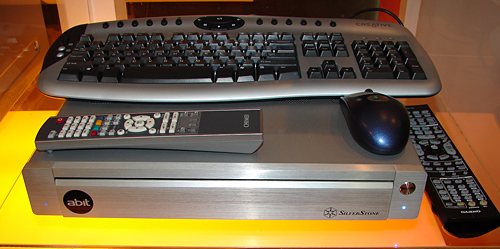
Abit is entering the growing Media Center PC market with their first products that include the ViiV based IL80-MV motherboard and the iDome digital speaker series.
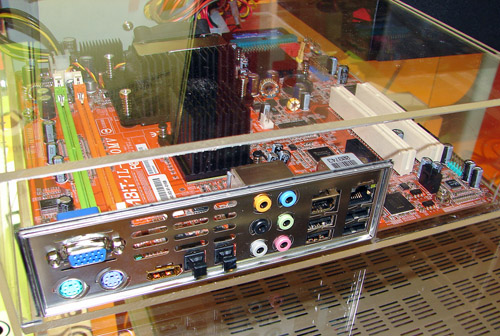
The IL80-MV micro-ATX motherboard is based on the Intel 945GT and ICH7mDH Express chipsets with support for the Core Duo / Solo (Yonah) processor range. Audio support from the Realtek ALC-882M includes full Dolby Home Studio certification, 7.1 channel output, and Optical S/PDIF in and out connections. HDMI output is fully supported by the on-board Intel GMA-950 graphics system. The system is totally silent and in our brief testing appeared to operate extremely cool in the SilverStone case.
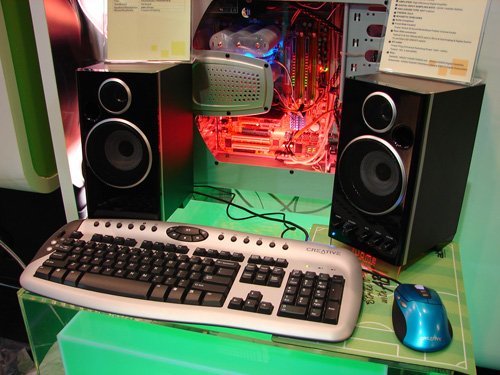
Abit is introducing the iDome DS500 speaker and iDome Sw510 subwoofer to the market later this summer. The iDome speakers support a pure digital audio stream process from input to final output, though you can also use them in analog mode if you so desire. The speakers and subwoofer will be sold separately but the 2.1 system on display consisted of two fairly compact speakers, the subwoofer, and an integrated digital amplifier. The cost for the two speakers will be around US $180 and another US $70 will get you the subwoofer. Both units will work with other manufacturers' products although for the price we recommend buying the set.
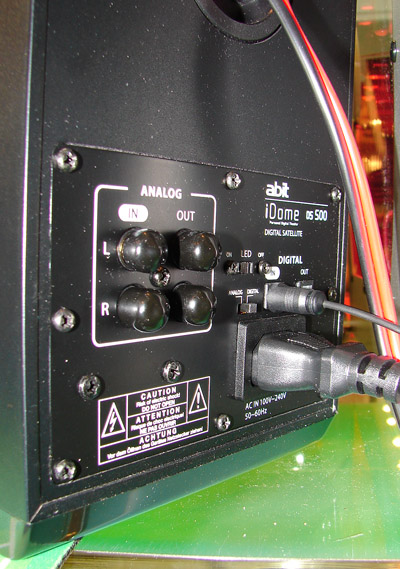
The back of the right speaker offers the choice of analog or digital input/output, as does the subwoofer. Each satellite offers 25W/per channel with the subwoofer providing 50W. The subwoofer features a 6.5 inch Super Bass driver featuring DBX technology providing a very deep bass tone with extremely little distortion in our listening tests. The satellites offer an independent 1 inch dome tweeter and 4 inch Neodymium drivers in a high quality case.
The speakers are controlled by a unique uGuru chip that allows for six different sound environments to be selected by the user, allowing you to tweak the processing dependent upon the audio stream being played. These modes consist of Normal, Game, Music, Movie, Rock, and Jazz. We had the chance to listen to these various modes before the show started and were very impressed with the satellites ability to deliver a very clean audio stream in a variety of situations from movie playback to gaming. The highs were clear and bright with the mids being very warm while extending downward to the point where there was noticeable bass response without the subwoofer. However, for games and movies we highly recommend adding the subwoofer.
Abit: Intel Motherboards
Abit is launching three different product lines this summer consisting of the Max, Fatal1ty, and Guru series. The Max series is targeting the overclocking enthusiast, Fatal1ty is for the gaming enthusiast, and Guru is the general computer user. Within the Fatal1ty series are three separate product groups based upon features and price targets; Champion, Professional, and Performance.
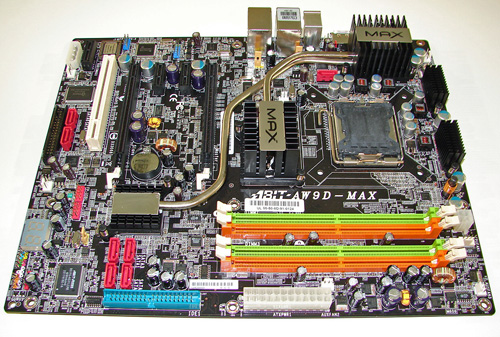
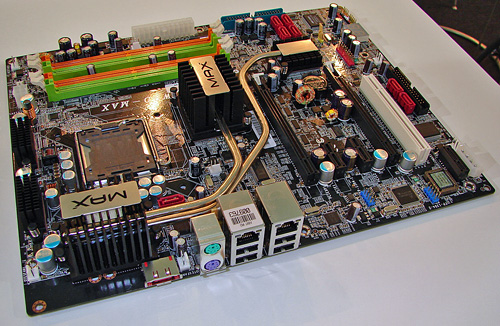
This is Abit's top of the line board featuring the Intel 975x and ICHR7 chipsets, ATI CrossFire support, silent OTES 2 cooling, OC Strips, uGuru clock, and AudioMax Technology featuring a separate riser card for the Realtek ALC882M HD codec. The memory slots will actually be colored coded black and white on the production series boards. Availability will be in early July with pricing around US $230.
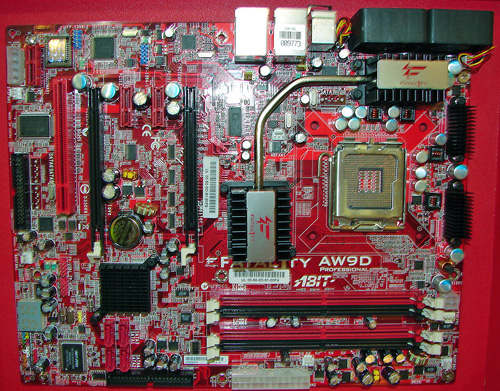
Abit's Fatal1ty Intel series features the Fatal1ty FP-A90 board with the Intel 975x and ICH7R chipsets along with Guru 2005, ATI CrossFire support, and AudioMax technology. Availability will be in July with pricing around US $215.
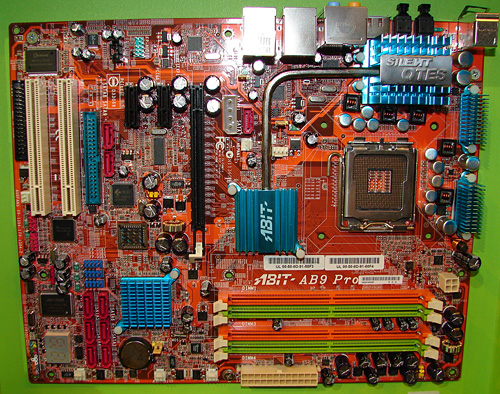
Abit's top of the line Intel 965 board is the AB9 Pro that includes two additional SATA 3Gb/s ports from a Silicon Image 3132 chipset along with one port SATA 3Gb/s and PATA (Ultra DMA 100) support from the J-Micro JMB363+ chipset. The PATA port is located in a very awkward position.
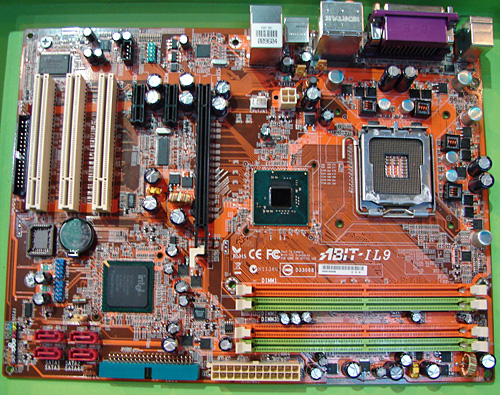
One of Abit's more budget minded Intel chipset Core 2 Duo boards will be the IL9 featuring the 946PL and ICH7 chipsets.
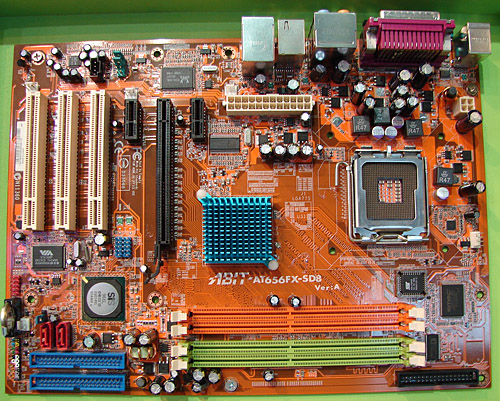
An interesting development in the low end boards that will support Core 2 Duo is the SD8 Pro that features the SIS 656 Northbridge and SIS 966L Southbridge. Expect to see this board retailing around the US $55 range and offering decent performance for a budget board.
Abit: AMD Motherboards
All of the following motherboards are expected to be available within the next few weeks. Here are Abit's offerings for the various price ranges.
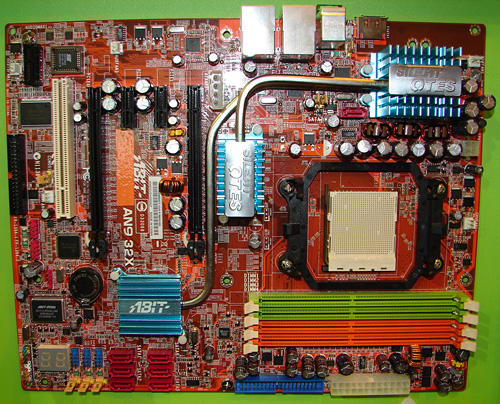
The AN9-32X is Abit's mainstream NVIDIA nForce 590 SLI board featuring two additional SATA 3Gb/s ports from a Silicon Image 3132 chipset along with the AudioMax riser card. The target price is around US $185.
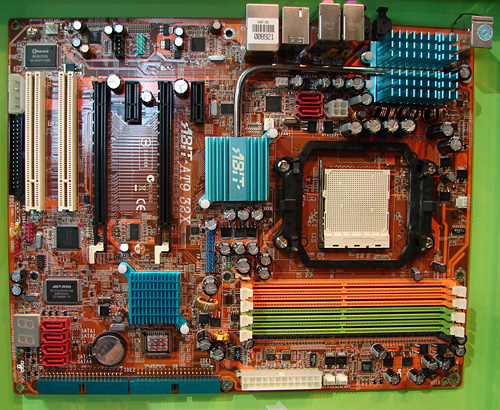
Abit's lone ATI AM2 board is the AT9-32X featuring the ATI Xpress 3200 and SB600 chipsets along two additional SATA 3Gb/s ports from a Silicon Image 3132. Pricing has not been finalized but expect it to be in the US $150~$175 range.
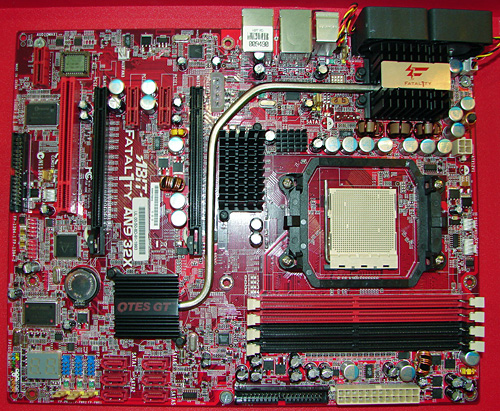
Abit's AMD AM2 Fatal1ty board features the NVIDIA nForce 590 SLI chipset, Guru 2005, and AudioMax technology. Pricing should be around US $200 dependent upon options.
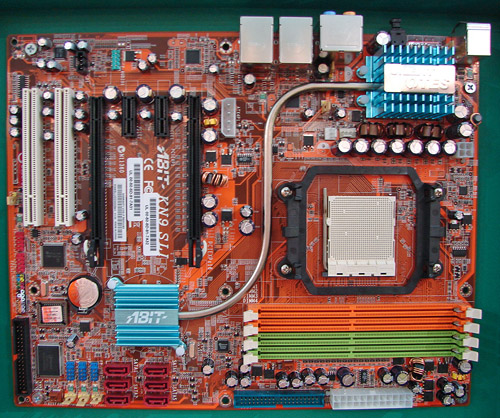
Abit's KN9-SLI board features the NVIDIA nForce 570 SLI chipset, Realtek ALC-883 HD audio, and will be aggressively priced in the US $115~$125 range.
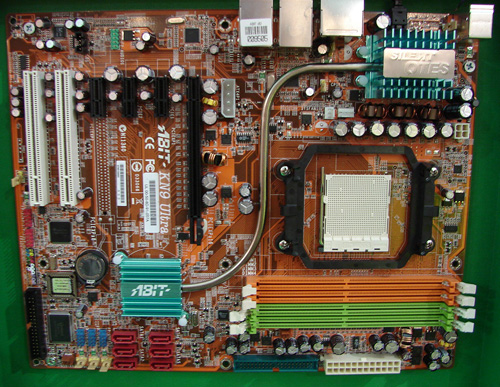
The KN9 Ultra board features the NVIDIA nForce 570 Ultra chipset, passive cooling, and Realtek ALC-883 HD audio. Expected pricing is US $90~$105.
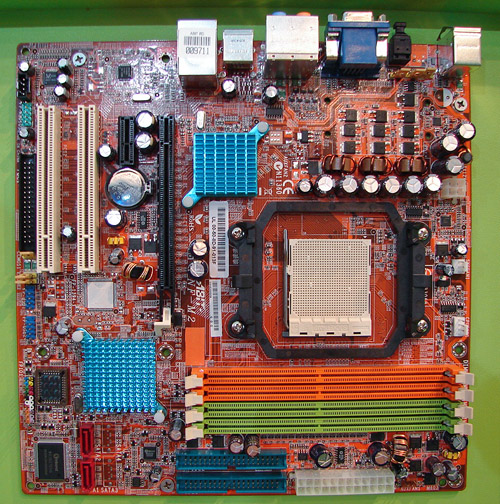
Last but not least is the Abit NF-M2 micro-ATX board featuring the NVIDIA GeForce 6100 chipset, and Realtek ALC-883 HD audio. This will be a value offering targeting the US $65~$70 price range.
All of Abit's new release motherboard products now feature passive cooling, a trend we witnessed with other manufacturers at the show. Abit will be aggressively pricing their products this summer so expect to see some very good price to performance ratios along with excellent product quality. In fact, the price targets we listed were very early estimates and could drop further at release.
The general tone around the Abit booth was one of excitement, certainly not the air of depression we witnessed last year. We were told that the first boards coming off USI assembly lines last week were approved without reservations and the quality even exceeded internal expectations. We expect to see some great products out of Abit shortly and hopefully the boards will perform as well as they look.

We spoke at length with Tomasz Swatowski, Marketing Assistant Manager; Kenny Tseng, VGA Marketing; and Jason Li, Marketing Specialist during our visit with Biostar. Biostar has been in existence since 1986 and has a long history of providing good products at very competitive price points. They have recently branched into the video card market with a wide array of offerings, and they continue to offer new SFF systems.
Their current focus is on expanding their business by offering higher quality products targeted towards the gamer and enthusiast markets. This includes top of the line NVIDIA based video cards along with higher end motherboards in the performance sector with their TForce series of products. Our recent review of their TForce 590 SLI Deluxe board certainly impressed us with the strides they have made recently in addressing this growing market segment.
Biostar: Intel Motherboards
While Biostar offers a wide variety of AMD based products, their focus at Computex was clearly on the Core 2 Duo boards.
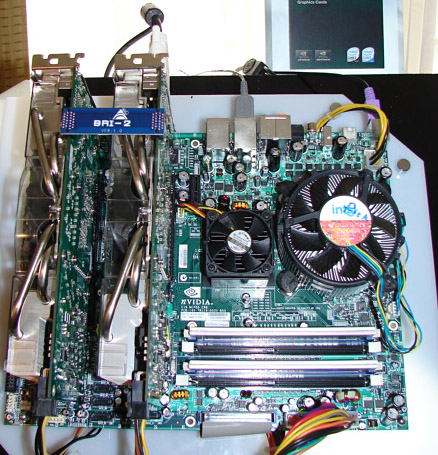
Biostar was one of several manufacturers demonstrating the reference NVIDIA SLI 590 board with full support for Core 2 Duo.
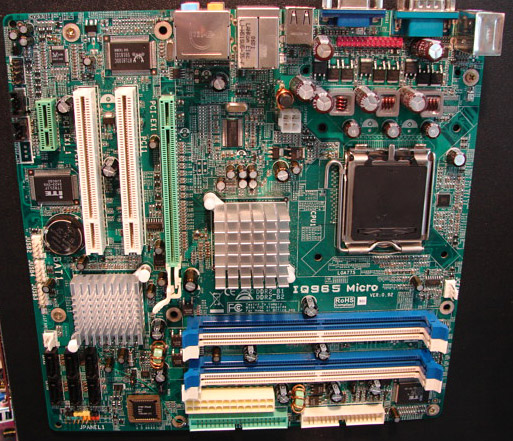
One of the more interesting boards we saw was the Biostar G965 Micro 775 board featuring the Intel 965G (X3000 integrated graphics) and ICH8 chipsets. Although Intel will not be ramping up the 965G chipset production until August, it appears that Biostar is one of the first to have working samples available for display.
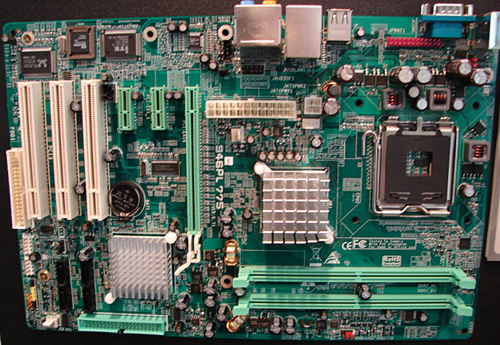
Biostar's budget minded Intel chipset board is the 946PL 775 featuring the Intel 946PL and ICH7 chipsets.
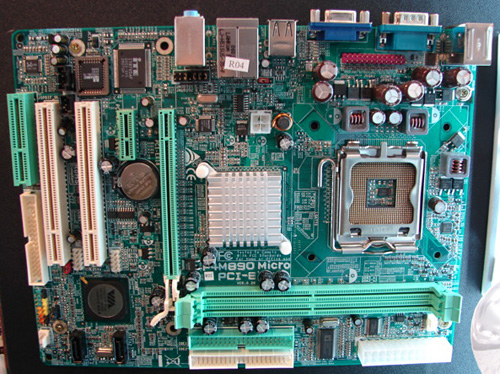
Biostar is offering two different VIA based boards that support Core 2 Duo with the P4M890-MY PCI-E board sporting the VIA P4M890 (IGP) Northbridge and VT8237R+ Southbridge. Expect this board and the more performance oriented PT890 775 (for VIA) to be available around the US $45~$55 price points.
Biostar: AMD Motherboards
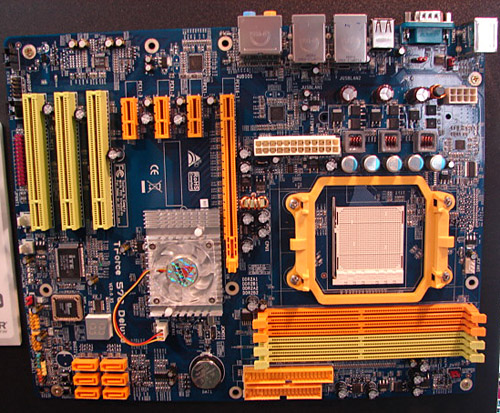
The TForce 570 U Deluxe board features the NVIDIA nForce 570 Ultra chipset, passive cooling, and Realtek ALC-883 HD audio. Availability is expected within a couple of weeks with pricing not set yet but expected to be in the US $85~$100 range.
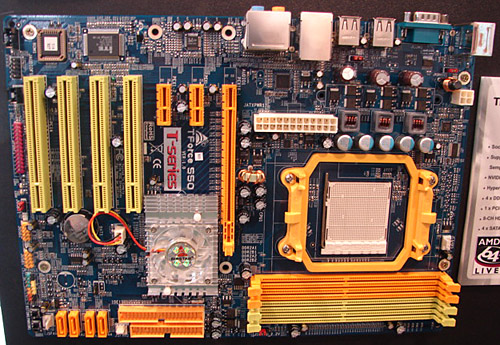
Biostar is one of the few manufacturers' offering both the NVIDIA nForce 550 and nForce4 AM2 boards. The main difference between the two is the lack of HD audio and Gb Lan on the nForce4 board. Like the 570 Ultra board, the TForce 550 utilizes active cooling for the MCP chipset. We can expect to see more passive cooling boards from Biostar in their next product release. The TForce 550 is already available and is one of the cheapest AM2 motherboards currently on the market.
Biostar: Video Cards
Biostar has recently introduced a complete line of video cards based upon NVIDIA chipsets ranging from the 7950 GX2 to the FX5200.
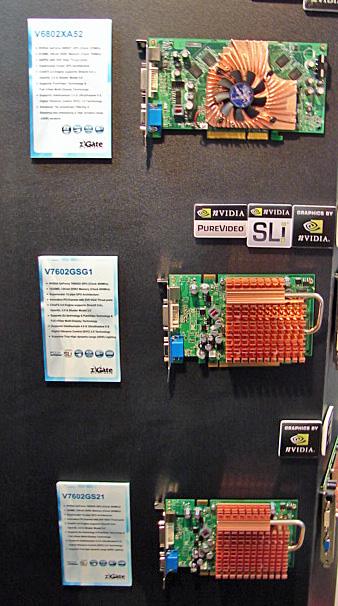
The above shot shows three of the more interesting video cards in the Biostar booth: the V6802XA52, V7602GSG1, and V7602GS21. The V6802XA52 features the 6800XT chipset on an AGP 8x bus with 512MB of DDR2 memory running at 700MHz with a core clock speed of 325MHz. While obviously outdated for today's latest systems, Biostar believes it to be a better upgrade path than other AGP based cards for those still running AGP based systems. Considering the amount of Intel 865 based boards we viewed with full support for Conroe this might not be a bad choice for those on a very limited budget. The V7602GSG1 is based on the 7600GS chipset but has 1024MB of memory running at 800MHz with a core speed of 400MHz and is passively cooled. This was the first 7600GS card we noticed with 1024MB of memory. Whether the card can utilize this amount of memory properly is debatable but it was nice to see cards including 1024MB at mainstream pricing. The V7602GS21 goes for a more common 256MB of video memory, for those that don't believe in overkill.
Biostar: Multimedia Products
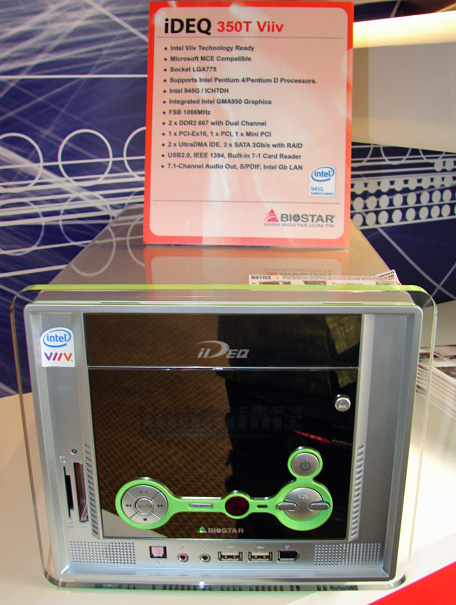
Along with a growing number of suppliers, Biostar is introducing Intel ViiV certified or ready products. The iDEQ 350T ViiV features the Intel 945G and ICH7DH chipsets along with an integrated FM Radio tuner, remote control, and front panel display unit. The front panel and top of the chassis is designed with a unique hinge that allows you to raise this section of the chassis and offers full access to the drive bays, CPU, and PCI-E slots. Although this system is not Core 2 Duo compatible, we should expect see one later this summer.
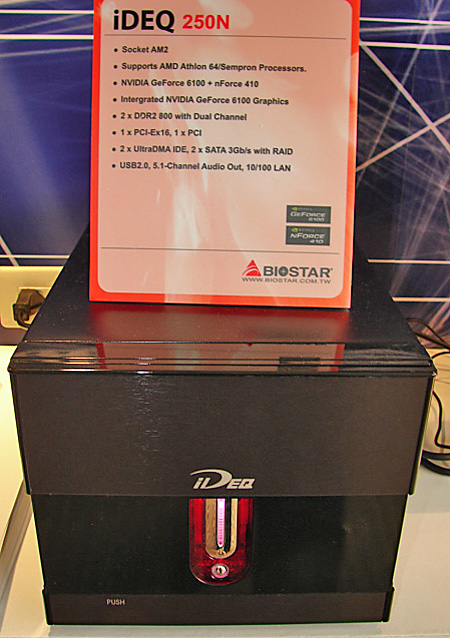
The iDEQ 250N is based upon the NVIDIA GeForce 6100 and nForce410 chipsets. This SFF unit is designed for AM2 processors and features a 220W passively cooled power supply along with an integrated system utility to control the chassis and CPU fan speeds.
Biostar also offers seven additional iDEQ units besides the ones shown. They plan on expanding this lineup in the near future along with additional chipset choices for both the AM2 and Intel Core 2 Duo series of processors. Overall, Biostar has excelled at taking the latest technology and bringing it to market quickly at inexpensive price points.

The amount of new products we witnessed in Thermaltake's display suites left us dizzy. Of course when we realized they employ close to 50 engineers in the Research and Design center the amount of new product introductions or revisions to existing product lines became understandable to us. We were welcomed with open arms by Annie Wu, Marketing Director; Weller Chen, OEM Product Marketing; and Jerry Lee, Marketing Assistant Manager. While we could spend the next ten pages or more describing all of the new products being launched by Thermaltake, we will spend time on a few products we thought were very interesting or out of the ordinary.
Thermaltake: Multimedia Products
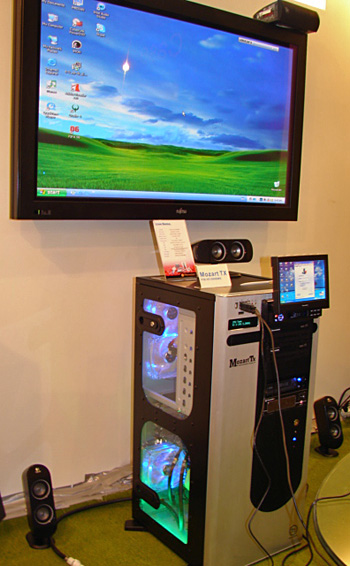
Thermaltake is releasing the first cube tower designed to handle two separate PCs in a single chassis. The case is specifically designed to meet the growing Media PC market with an emphasis on providing a solution that allows you to install a high performance gaming or workstation system while still having the necessary room to install a system designed to work as a HTPC or media playback machine.
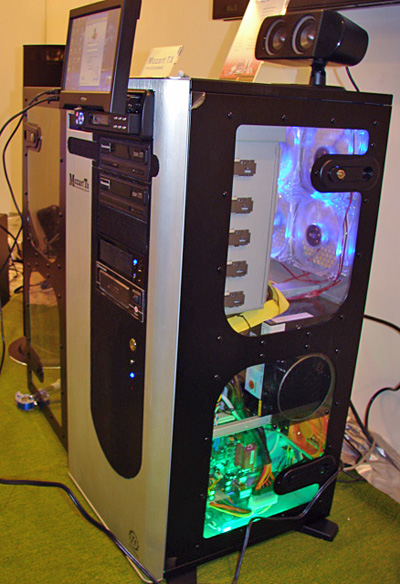
The case features the ability to handle a 7 inch Drive Bay with full support for a manual or retractable 7 inch LCD monitor (1280x768) that operates as a stand alone analog monitor. The case is fairly compact with measurements of 720mm x 330mm x 360mm (H/W/D). The depth measurement of 360mm is about 35% less than the typical 550mm depth of the average tower case.
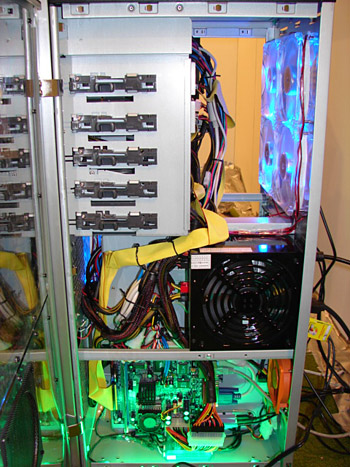
The doors are easily removed and the right side of the case is sectioned off for the mini-ITX board. The case is designed to handle an ATX/micro-ATX, or Standard/Micro/Pico/Nano BTX motherboard on the left side with the right side being reserved for the mini-ITX boards. While we would have preferred micro-ATX capability for the secondary board, the good news is that several of the mini-ITX board designs we saw were sporting recent chipsets and processors that would not have an issue powering a basic HTPC configuration.
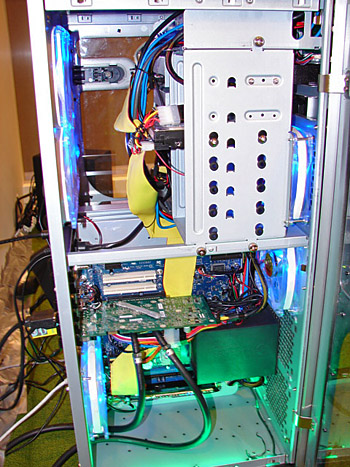
The left side of the case is sectioned off for a full size ATX or BTX capable motherboard. In this example, Thermaltake installed a BTX board and its unique cooling system. The case is actually sectioned off into four separate thermal areas with each section being totally independent of the others in the generation of airflow and removal of heat.
Thermaltake: Multimedia Products
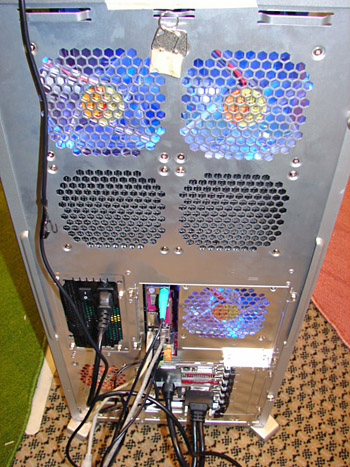
A quick look at the rear of the case reveals the five exit points for the included 120mm ultra quiet fans and 80mm vent for the secondary system. The system we viewed was set up with eight fans and actually was very quiet during operation which surprised us. The case itself can hold a total of ten 120mm fans and a single 80mm fan or you can mix and match the number of fans with cooling radiators if you install a liquid cooling system. The system can handle up to two 12 x 24cm radiators when utilizing four of the 120mm vent points. The case also has four 19mm holes drilled at the bottom left corner to handle liquid cooling tubes.
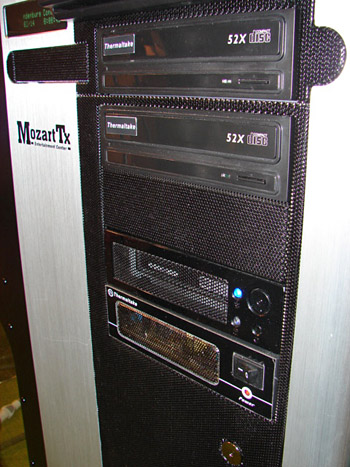
This close up of the lower front panel displays Thermaltake utilizing one of their slot based power supplies for the mini-ITX board.
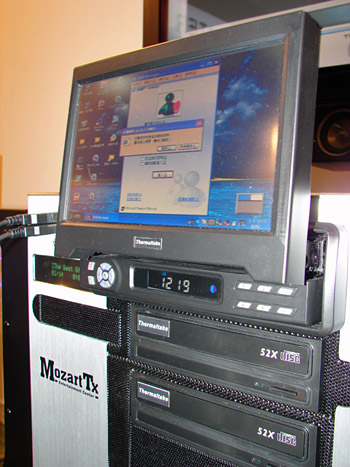
A close up of the 7 inch drive bay in operation. Thermaltake is expecting to sell this retractable 7 inch LCD unit as a separate option for around US $250. The LCD panel is not included with the case.
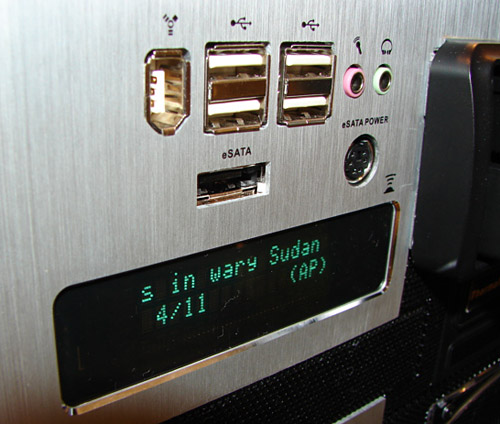
The Mozart TX features an e-SATA port along with the capability to power this port from the same location. Overall, this is a very interesting case with a lot of potential for the right customer. The case is very sturdy, both doors swing open a full 90 degrees for easy access, the 5.25" drive bays and PCI card slots are tool-less designs, and the hard drive bay is removable with shock absorbing grommets designed to reduce noise and vibration.
Thermaltake: Desktop Cases
Thermaltake is in the process of introducing several new cases in the HTPC, LAN, and performance desktop (requires a large desktop) categories. Some of our favorites or ones that caught our eye are shown below.
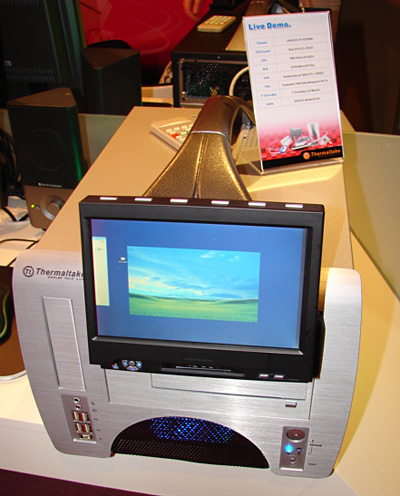
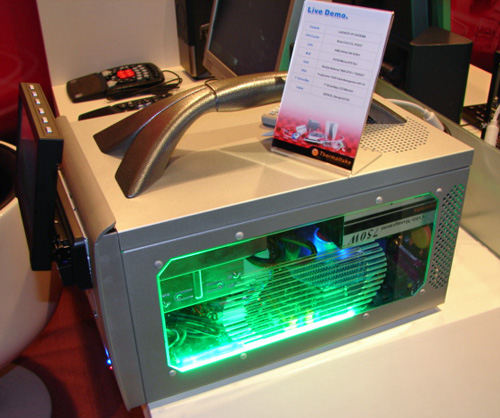
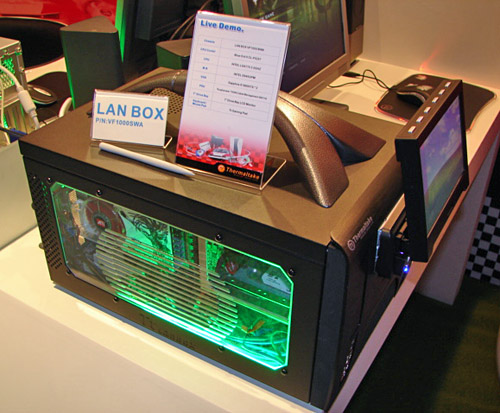
The LAN Box is one of our favorites as it features the ability to utilize the 7 inch LCD panel mentioned already along with a full size power supply. The units come in silver or black and felt very sturdy along with having easy access to the components in less than a minute.
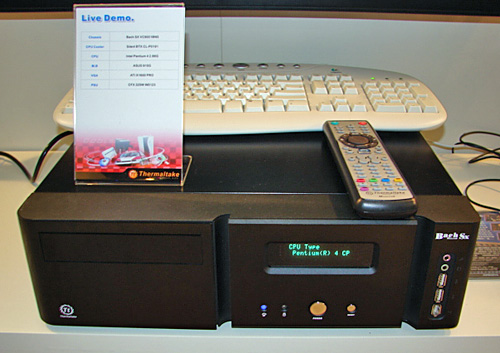
The Bach Sx is a great follow up to the previous Bach series and should make waves in the HTPC world with improved thermals, interior accessibility, drive storage, and Media Lab functionality.
Thermaltake: Tower Cases
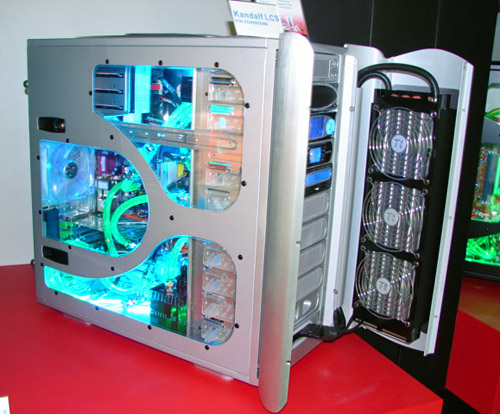
The Kandalf LCS series was designed with liquid cooling in mind as the right front door panel holds Thermaltake's 360mm radiator that is cooled by three nearly silent 120mm fans.
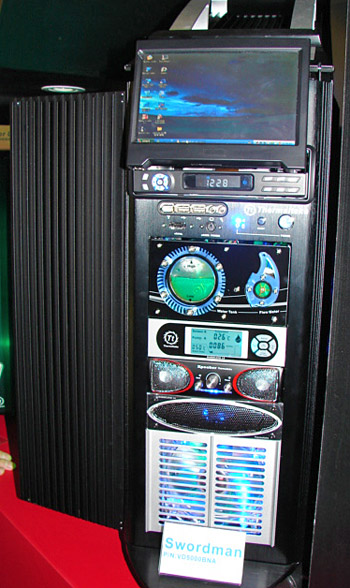
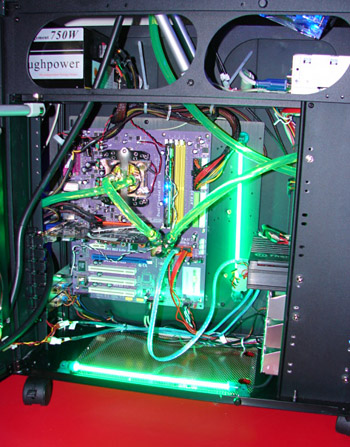
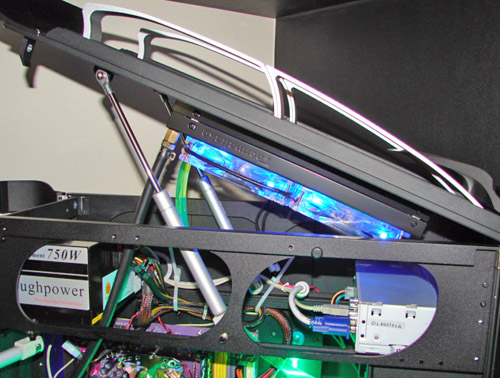
The Swordman is designed for the uber geek with full support for the 7 inch LCD panel, hydraulic controlled top, a multitude of drive bay options, and a case interior designed for liquid cooling. It's definitely going for the bling factor.
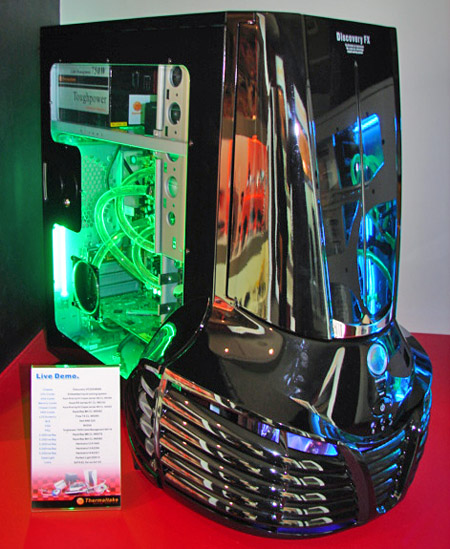
Last is the Discovery FX featuring a retro alien head front cover that actually hides a custom designed liquid cooling system from Thermaltake.
Thermaltake: Power Supplies
As we mentioned in our preview coverage, the next generation GPU solutions are going to need additional power with an overclocking enthusiast level system probably requiring a 850W to 1000W power supply or a separate power supply for the dual GPU cards.
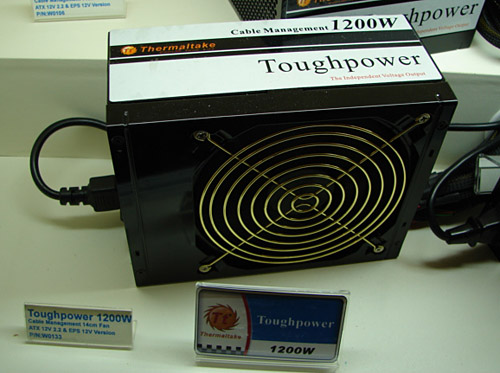
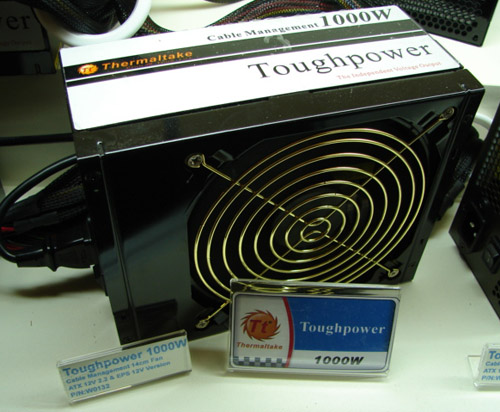
Thermaltake will be introducing a class leading 1200W and its little brother 1000W power supply this fall.
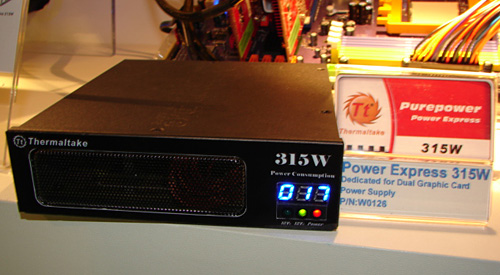
Thermaltake is also introducing a class leading 315W power supply dedicated to dual graphics card installations.
Thermaltake: Storage Options
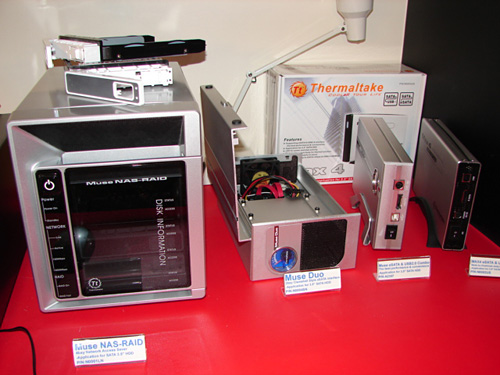
Finally, Thermaltake is expanding into the external storage case market with numerous options that range from a NAS-RAID housing to several elegant single drive clam style case enclosures. Of course, Thermaltake continues to offer a wide selection of CPU/GPU cooling options that can be located at their website.
We will continue our Computex 2006 coverage over the weekend with a look at additional motherboards, memory, multimedia products, and an interview with a Vice President of Acer in our next article.







